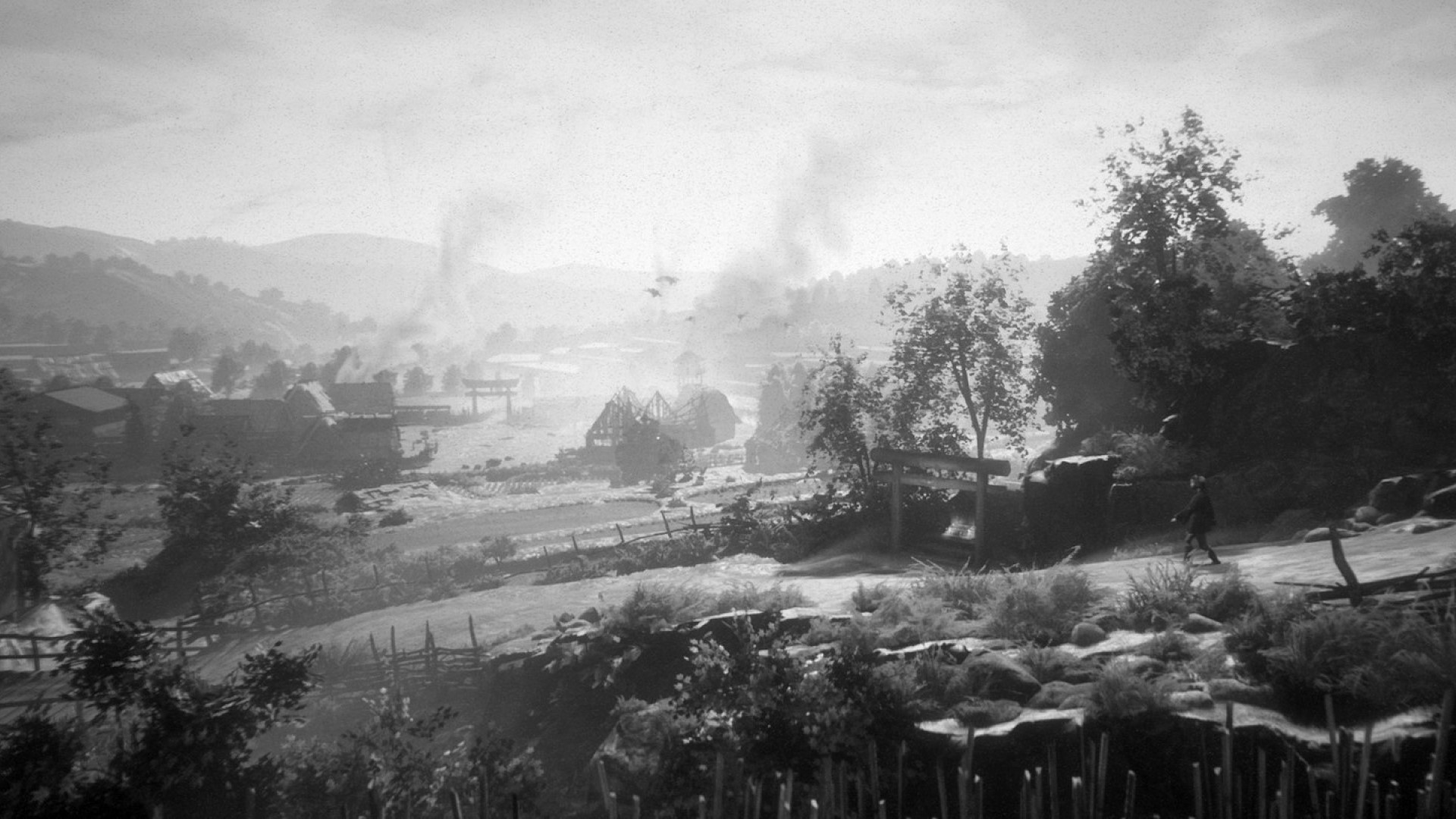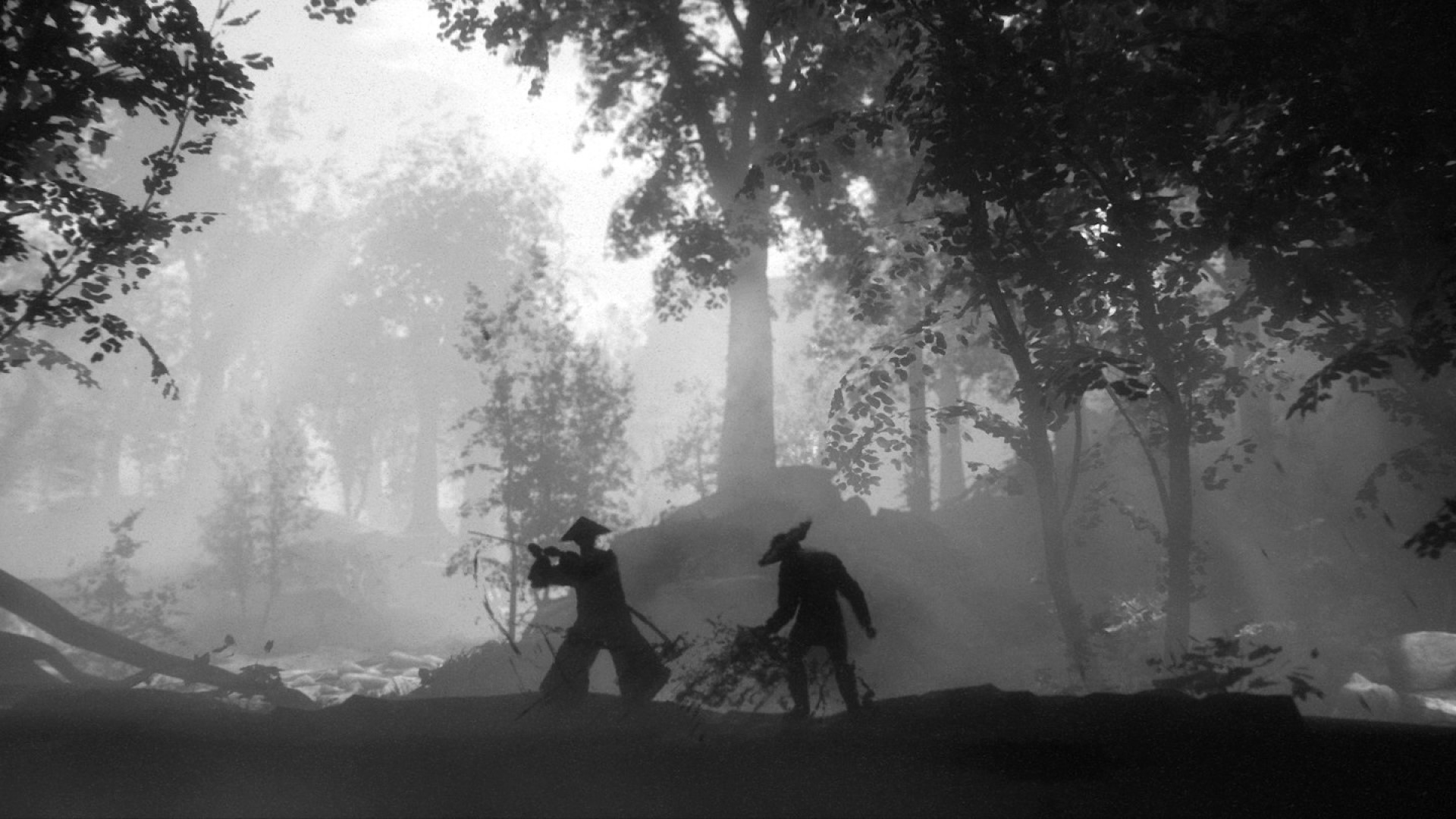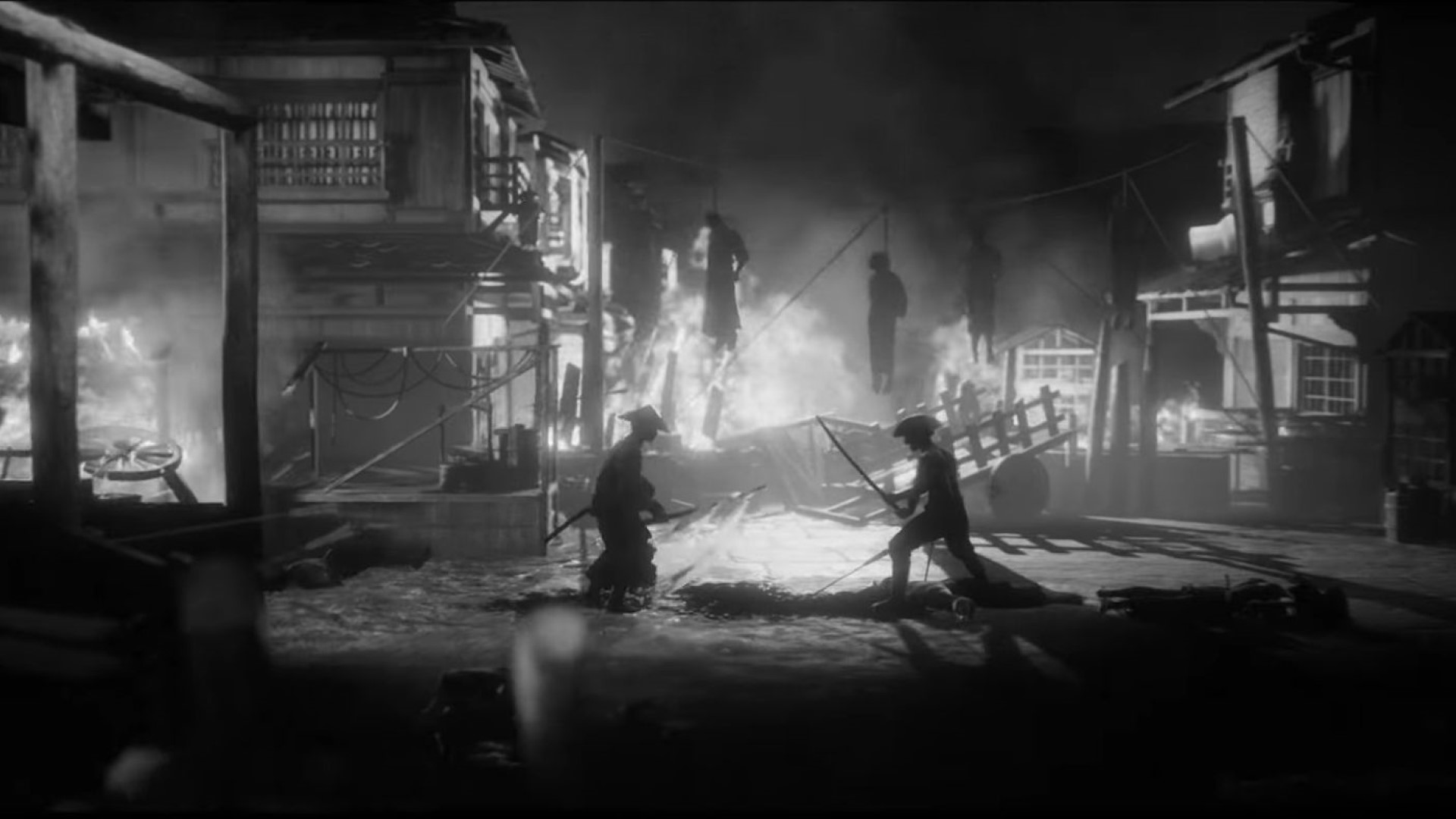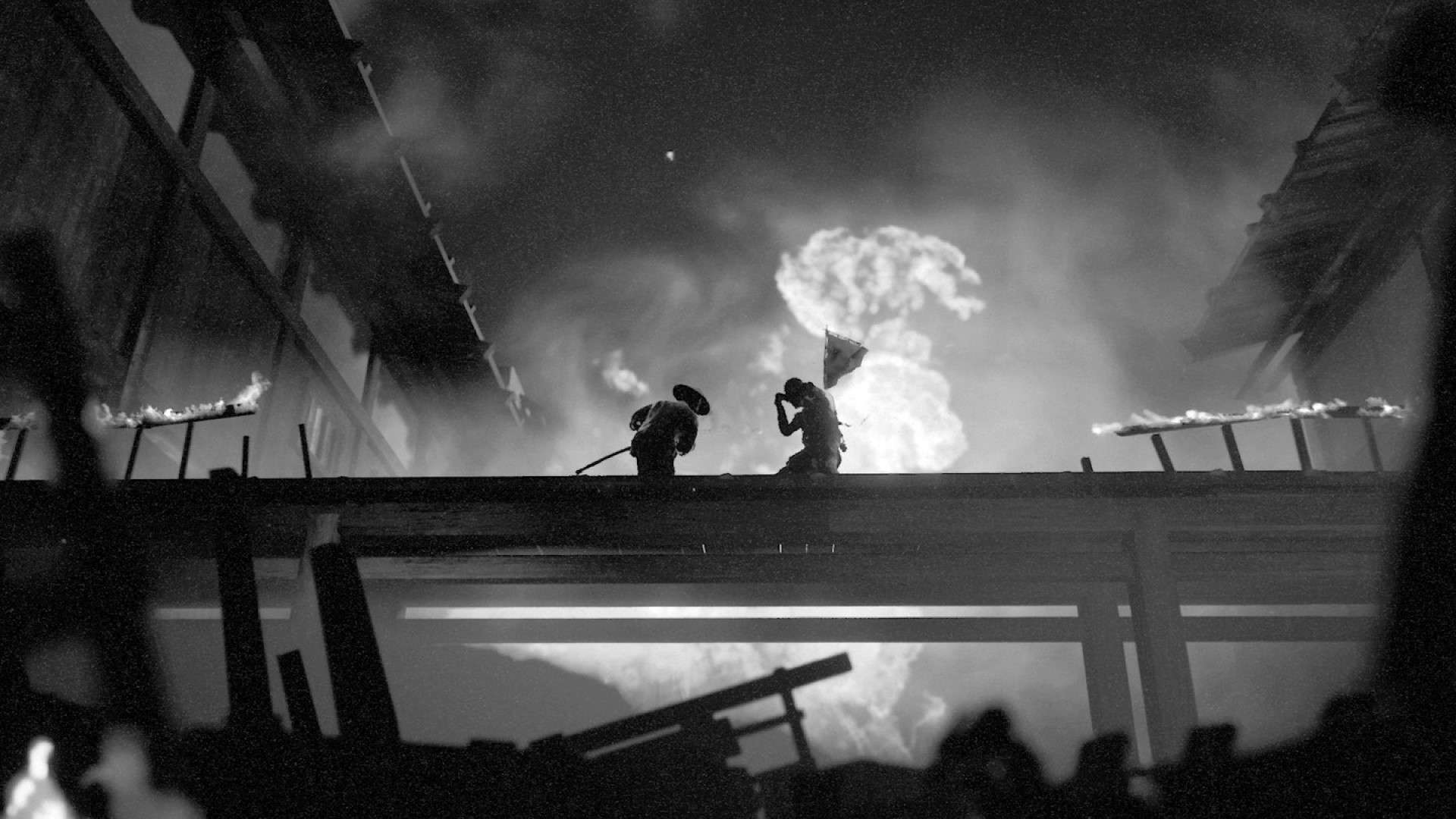The Kurosawa mode in Ghost of Tsushima might not have been the ideal way to play that game, as it sacrificed so much of the game’s visual spectacle, but it certainly was an interesting little love letter to the classic Samurai movies of the 1950’s and 60’s that inspired so much of the tone and style of the game. The question of what a game would be like if it were fully dedicated to that visual style might have crossed gamers’ minds since seeing it deployed in Sucker Punch’s samurai masterpiece; it certainly did mine.
Well, it looks like Devolver Digital and Flying Wild Hog are well on their way to answering such a question, albeit with a very different type of game. Trek To Yomi, for better or for worse, is looking to be that game with a total and unflinching dedication to the black and white, grainy look of a mid-20th century samurai movie resting on the foundation of a 2.5D hack ‘n slash action game. I’ve had some time to play the game prior to its upcoming release on May 5th and during my playtime I’ve become quite familiar with it, and while it certainly isn’t without it’s flaws, I still think there are plenty of reasons for those who have been keeping an eye on this game to continue to do so. Here’s 5 of them.
THE VISUAL STYLE
Right off the bat, there’s no reason to elude the most immediately striking characteristic of Trek to Yomi; it’s absolutely spot-on art direction and visual style. Perhaps even better than Ghost of Tsushima’s Kurosawa mode, Trek to Yomi’s vintage presentation is absolutely drenched in its totally desaturated grayscale palette from head to toe. Even the opening credits and in-game menus fit into the aesthetic. Some nice effects like a slight intermittent flicker, film grain, and some over-exposed shots elevate the look to about as convincing a level as can be hoped for, so I suspect those looking for an authentic experience of this sort won’t be left wanting – at least in the presentation department.
Without an ounce of color anywhere though, it can be tough to tell some characters apart and pick up on where the game wants you to go next. I also occasionally find myself walking right past items or characters of interest with only minimal visual cues that tend to blend into the background. but given that this is a largely linear affair, this is a small price to pay for the sheer amount of credibility that the presentation brings to the adventure. Perhaps some more contrast on objects of interest to make them pop a bit more would help with that, but it would also risk breaking the immersion, so I can understand any hesitancy the developers might have with that. Even still, with the authentic film look effectively conveying the era, there are also lots of nice environmental effects like embers rising from fires and misty rain storms obscuring certain scenes in a cinematic way.
AN AUTHENTIC STORY
Most of the classic samurai films of the 50’s and 60’s told fairly simple stories. They usually revolved around immediately understandable concepts like revenge, honor, and doing what’s right for the greater good, but some also played with more intimate themes like facing your personal demons and coming of age. Without spoiling anything, I can safely say that Trek to Yomi is taking a stab at many such common threads. Our main character Hiroki is a young but talented swordsman who finds himself needing to summon every last bit of his courage to defend his town before he’s really ready. As a character that takes his vows and duties ultra-seriously, his lack of experience must be outmatched by his courage. It’s a tale as old as time, but fits so snugly into the fabric of the setting that it’s impossible to not cheer Hiroki on from the get-go.
ENGAGING COMBAT
A serious samurai game isn’t going to add up to much without iconic katana-wielding combat encounters, and Trek to Yomi thankfully seems to understand that. Each encounter is tailored for the context of the situation, with enemies often trying to intimidate Hiroki by remarking about his young appearance and obvious inexperience. Hiroki sometimes responds in kind, with retorts that ring true of an unlikely hero driven more by heart than by brawn. Once battles commence, they can be over quickly and easily fall in or out of your favor.
The combat isn’t particularly flashy or snappy, which might feel a bit off-putting at first, but it also instills a sense of consequence with every block, parry and strike. Combos and finishers can also be learned and perfected, resulting in a bit more depth than most games of this type tend to have. Enemy variety did leave me a bit wanting in the first handful of sections of the game, and I often found the same couple of techniques could dispatch the vast majority of the game’s early foes, but as enemies grow in number and end up on either side of Hiroki, the combat shines a bit brighter. Wise choices in combat are rewarded just as fast as bad ones are punished, making combat a tense affair.
TOP-NOTCH AUDIO
A game’s audio department is often overlooked, and in some games perhaps you can get away with mediocre audio, but a game like this needs at the very least solid offerings in music, voice acting, and sound effects to make the experience work. In my experience with the game so far, I’m rather impressed. Voice acting and music in particular really sell the setting and authenticity of the various scenarios Hiroki finds himself in. Swords clashing with each other and the flesh of their targets are accompanied by suitably intense sounds, but perhaps not as interesting as the rest of the audio landscape.
A FOCUSED EXPERIENCE
With a lot of games trying to meld multiple genres into new and versatile combinations in an effort to appeal to as many people as possible, Trek to Yomi is a refreshingly focused game, driven by its own vision to cater to its very particular audience, and little else. In essence, it’s a game that wears its heart on its sleeve, providing an outstanding experience to fewer players than many other mainstream games that aim to provide a good enough experience to the masses. Whether Trek to Yomi is something that directly appeals to you or not, it’s hard to not respect it for that.
While Trek to Yomi isn’t breaking down any barriers for side-scrolling action games, and I do have some concerns about it succeeding to spread its ideas across an entire game without feeling too thin by the end of it, it clearly is pulling off what it’s trying to be in most ways. A reasonably challenging action game with an intense focus on the aesthetics of classic samurai movies. Even if it ends up falling a bit short by some conventional metrics, there is certainly a place for it in the genre.
Note: The views expressed in this article are those of the author and do not necessarily represent the views of, and should not be attributed to, GamingBolt as an organization.
- About
- across
- Action
- Adventure
- adventure game
- aesthetic
- appeal
- appeals
- around
- Art
- article
- audience
- audio
- Authentic
- authenticity
- barriers
- BAT
- before
- Bit
- Black
- challenging
- characters
- coming
- Common
- continue
- could
- Couple
- Credits
- dedicated
- department
- developers
- devolver digital
- DID
- different
- digital
- Dispatch
- down
- driven
- During
- Early
- ELEVATE
- ends
- environmental
- essence
- experience
- eye
- fabric
- facing
- FAST
- Film
- films
- finds
- fires
- First
- fit
- flaws
- Focus
- focused
- Foundation
- game
- Games
- Ghost
- good
- Grayscale
- Grow
- hack
- head
- help
- HTTPS
- i
- immersion
- in-game
- interest
- IT
- keeping
- learned
- Level
- love
- Mainstream
- Majority
- Making
- masterpiece
- May
- Metrics
- mine
- more
- movie
- Movies
- Music
- Offerings
- opening
- Other
- Pay
- People
- play
- players
- Plenty
- possible
- price
- pulling
- reasons
- release
- REST
- Ring
- Risk
- s
- safely
- sell
- sense
- setting
- Short
- Simple
- small
- So
- spread
- Stories
- style
- techniques
- The
- time
- vintage
- vision
- visual style
- Voice
- walking
- What
- WHO
- Work
- youtube















